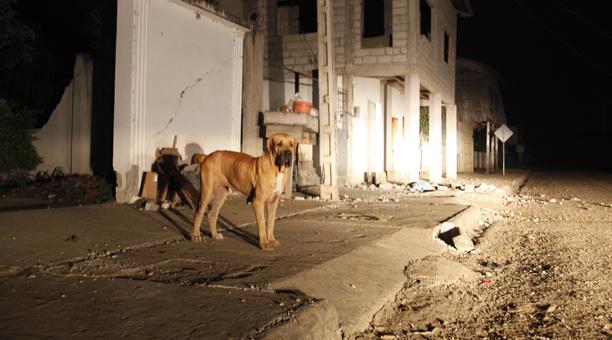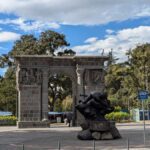Ecuador’s dogs keep cropping up in post-earthquake news. From day one, when dogs were found guarding the remains of their owners’ homes, their stories became some of the most widely shared in social media circles. Here are some of the most shared:
The Hopeful
This is a story true to almost every community on the coast. A fallen building, few survivors, and a lone dog guarding the home.
Negro became famous for refusing to leave the front of his fallen home. At first, he refused food and water from strangers’ hands but after a while, he began to trust other people.
The good news is that his owner, Remigio Oña, found Negro waiting for him and they have been reunited. It is a small story of hope in so many desperate days.
The Rescued
Negro is a lucky dog because he was reunited with his owner. But his story is rare. It is, for this reason, we are so thankful to the many people in Ecuador who are willing to help lost animals.
The National Police, via the Centro Regional de Adiestramiento Canino (CRAC), have set up two rescue locations on the coast, one in Manta and the other in Pedernales. They are bringing dogs from other towns to these two locations. The hope is that Ecuador’s dogs from the coast will be adopted locally though there are plans to eventually bring some of these animals to cities like Quito and Cuenca.
The Rescuers
Some pets have been both rescued and become rescuers. Dixi, a cute little pug-nosed dog, has become a local hero in Muisne because she loudly barks just before the arrival of an aftershock, warning her human friends to prepare for the incoming tremor.
But most rescue dogs are trained animals. Take for example, Killy. He is a rescue dog that received wounds to his right front foot while working in the Tarqui neighborhood of Manta. Before having to leave the rescue scene because of his injuries, Killy saved 6 people hidden under the rubble.
The working conditions for the rescue dogs are dangerous. Dogs like Killy could use items like boots to help protect their paws from sharp objects often found in destroyed buildings. But the hot weather on the coast is a concern for both working dogs and their handlers.
Dayko, a working dog from Ibarra, saved 7 human lives in Pedernales before succumbing to what was likely heat exhaustion. He has become world famous and written about in newspapers around the world.
Photos of Dayko show his handlers working hard to save his life. Working dogs are a special breed because they will literally give their all to save humans and it is important that their handlers learn the physical signs of stress. Sometimes in our attempts to save more people, we place ourselves and our animals in conditions that place all of our lives in danger. It is a delicate balancing act.
How You Can Help Dogs in Ecuador
Many organizations are taking donations to help save pets and to protect working dogs. Although it does help when locals donate items like food and medicines, money is the best donation of all. With cash in hand, locals can buy supplies and have them delivered to the places in most need.
Help for Working Dogs
Although the time for saving people from the rubble is coming to end, working dogs will still be out there. Many are trained in finding dead bodies, work that is incredibly difficult for both handlers and their working partners. And as tremors continue, there may be new damage to come.
Working dogs need your help. One American living here in Quito, Ecuador is helping to provide boots for working dogs so that animals like Killy won’t have to deal with dangerous injuries to their paws and legs. If you would like to help, please visit Rosi Smith’s GoFundMe page to buy Boots for Rescue Dogs.
To help with general supplies that will help rescue dogs, the Animal Rescue Foundation of Ecuador can take donations directly to this bank account:
-
- Banco del Pacífico #7408994, a la cuenta corriente
-
- Fundación Rescate Animal Ecuador, Ruc 0992767774001
Help for Animal Rescue
Many Animal Rescue Organizations are working in communities throughout Ecuador and some have fundraising pages. If you have one you would like to add to this list, please leave a comment below. Organizations with websites and information on how to donate are the most likely to receive monetary donations.
At a national level, there is a three stage plan:
- Feed and help pets in the affected areas.
- Capture and move pets to central locations outside of the earthquake zone.
- Find families to adopt the animals.
At a local level, these animal shelters are asking for help:
Cuenca – Rescate Animal Cuenca has a reputation for helping abused, abandoned, and neglected animals. Currently, they are accepting animals from the coast and matching them with families in Cuenca. See their Facebook page for dogs that are needing homes. If you would like to donate, they have a general GoFundMe page.
Manta – Esperanza Canina, an animal rescue center in Manta, has been destroyed. If you can help with food or medicine for animals or cleaning supplies for the rescue center, please drop off donations at Avenida 24 between Calles 12 and 13 in the offices of Salud Global. If you can help with a cash donation, they have a PayPal account. Send money to esperanza.canina.manta@gmail.com. Or you can add money to their local Ecuadorian bank account:
Banco Internacional
Cuenta de Ahorros #7100783879
Name: Funcacion Esperanza Canina
RUC: 1391814933001
Mompiche – If you can help buy supplies for an Animal Rescue Center in the coastal town of Mompiche, visit this GoFundMe page.













0 comentarios